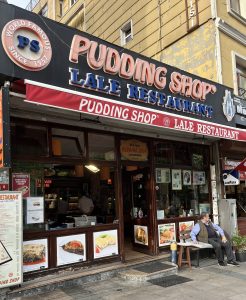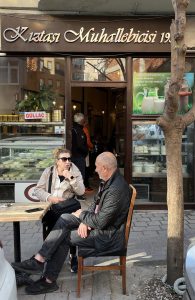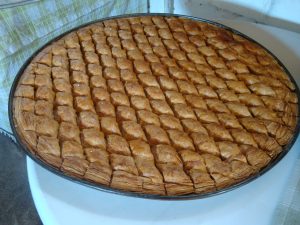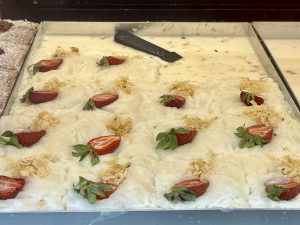The pudding shop

Anyone who has ever watched Midnight Express will remember that part of the action took place in The Pudding Shop on İstanbul’s Divan Yolu. That pudding shop is still in business although these days there’s nothing but the name to distinguish it from the other small restaurants nearby. But there was a time when the pudding shop or muhallebici was a standard feature of Turkish towns and sold only puddings. Right into the middle of the 20th century the muhallebicis clung to life, offering an assortment of milk-based desserts (actually, “milk-based” was something of a misnomer as the base for all these dishes was really şübye, which is extracted from rice by soaking it in water and then grinding it to paste), including the eponymous muhallebi which was a form of blancmange. But the most popular dish was fırında sütlaç (oven-baked rice pudding), which was served in clay bowls or small glass dishes with the browned skin left on top. Occasionally you will still come across pushcarts selling rice pudding, especially late in the evening.

Other featured puddings included:
- Keşkül – milk and almond powder pudding sprinkled with ground almonds and pistachios
- Tavukgöğsü – one of Turkey’s most peculiar dishes consisting of a sweet milk pudding to which pureed chicken breast has been added
- Kazandibi – tavukgöğsü with a caramelised crust
- Supangle – thick chocolate mousse served in individual ramekins, sometimes with a ball of choux pastry in the middle so it’s like a profiterole in mousse
You can still get all these puddings but by the end of the 20th century the stand-alone muhallebicisi had virtually died out. In the early 2000s they had a brief revival in the form of branches of Bolulu Hasan Usta (BHU) which stuck with the traditional pudding shop recipe and offered only glasses of water and no coffee to go with the dessert. Branches of Özsüt tried harder with an array of scrumptious cakes and a full range of coffees alongside the puddings. But this was not a viable business model for the 21st century and the one survivor from that period is the Saray Muhallebicisi chain which started life in 1935 and now offers soups and kebabs to go with the sweets.
The baklava emporium

The modern equivalent of the pudding shop is probably the baklava shop which offers a wide range of sticky-sweet confections, not always with main-course food to go with them although always with coffee too. Like milk-puddings baklava comes in a wide variety for forms.
Other sweet treats
Aside from the milk-based puddings and a wide variety of baklavas, contemporary restaurants and cafes also offer sponge and bread-based desserts. Typical is revani which is made from semolina and ground pistachios flavoured with vanilla and soaked in syrup, best when served with a dollop of cream, better still when that cream comes from a buffalo (manda). More common is şekerpare which is made using pre-packaged biscuits that can be soaked in a lemon-flavoured syrup; each biscuit has a pistachio stamped in the middle of it; Kemalpaşa looks similar but is made from sponge pudding soaked in syrup. Ekmek tatlısı is basic bread pudding sometimes perked up with fruit toppings, especially sour cherry (vişneli).
Given the amount of fruit available in Turkey it’s hardly surprising to see all sorts of fruit-based puddings on sale. The most common are probably kabak tatlısı (pumpkin dessert), ayva tatlısı (quince dessert), and incir tatlısı (fig dessert) but you will also see plenty of fruit conserves known as hoşaf too.

Aşure
In a class of its own is aşure which is more or less a meal in its own right and is sometimes called Noah’s Ark Pudding because of claims that the original aşure was made by Noah’s wife towards the end of the Flood when she mixed together a little of all the forty separate ingredients left in her store cupboard.
So popular is aşure that there is a whole festival devoted to it, namely the 10th day of the Muslim month of Muharrem (this changes in date every year because the Muslim year follows the lunar calendar). That date is the anniversary of the death of the martyr Hüseyin, the grandson of Mohammed, and is especially important to Shiite Muslims. Most Turks may be Sunni but the Bektaşi sect originally based in Hacıbektaş in Central Anatolia followed many of the same rituals and helped secure a home for aşure in the Turkish calendar. Many other events are also tentatively attached to this date: the day Adam met Eve, the day Allah forgave Adam his sins and perhaps most appropriately the day that Noah finally set foot on dry land after the Flood. In many parts of Turkey women still make aşure and distribute it to their neighbours.
By its very nature aşure is a hotch-potch of a dish and every housewife has her own favoured combination of ingredients, but typically the pudding might contain any of the following mixed together using a special flour called aşurelik to form what is rather like a rich, sweet minestrone: barley, chickpeas, lentils, beans, bulgur, sultanas, apricots, cherries, walnuts, hazelnuts, figs, orange peel, pine kernels and pomegranate seeds. A less commonly cooked variant uses milk mixed with water as a basis. Don’t expect to find exactly forty ingredients – the number has many important connotations in Middle Eastern culture which probably explains why it was picked.
Aşure is sometimes available in normal cafes, but on the day of aşure bayramı (the holiday linked to the marytrdom of Hüseyin) you may see empty shops hosting groups of women who have got together specifically to make and sell it. Aşure also forms an important part of Alevi ritual and on the bayram cemevi communities sometimes make and distribute aşure within their community.
Künefe and katmer
A much-loved dessert that is a specialty of the area around Antakya and the Hatay is künefe which is made from a combination of freshly-made sweet shredded wheat noodles and a special gooey cheese that is placed in the middle, then melts into it perfectly. The noodles are made by dribbling a flour, sugar and water paste onto a piping hot griddle as it rotates using a special ladle pierced with a row of holes, and then quickly scooping the crisp end product off again. Meanwhile the cheese is prepared separately ready to be mixed with the noodles before baking – it’s a special cheese that is not used for any other cooking purpose. Then the whole thing is baked until crispy whereupon a sugary syrup is poured over the top and it’s sprinkled with grated pistachios.
Fresh künefe takes some time to prepare so unless you are in a pastry shop that sells nothing else you should order it at the same time as your starter and main course. Perhaps the best thing about künefe is that the cheese takes the edge off the sweetness making it perfect for people who find baklava a bit too syrupy.
Katmer is also popular in the Hatay and consists of crispy layers of flaky pastry layered with clotted cream and sugar, and sprinkled with pistachios.
Zerde
If you see bowls of a particularly lurid-looking orange dessert in the windows of a pudding shop it will be zerde, a rice pudding made from saffron mixed with rose-water and thickened with arrowroot or potato flour. Like aşure, zerde has an interesting history since it was one of the items served to the famous Janissary soldiers in bowls on the ground when they arrived at the Topkapı Palace for their three-monthly payday. Every Thursday it was also served to the poor from İstanbul’s many imarets (soup kitchens) to celebrate the approach of Friday, the Muslim holy day. The Tarihi Haliç İşkembecisi (Abdülezelpaşa Caddesi No. 117, Fener; Tel: 0212-491 0100) on the Golden Horn always stocks it.
 Güllaç
Güllaç
Usually only available during Ramazan, güllaç is another milk-based pastry dessert but this time flavoured with rose-water and topped off with pistachios, walnuts and pomegranate seeds. It appears to have existed in some form since the 14th century and may even have sparked the development of baklava.
Read about Turkish ice cream: Ice Cream in Turkey
And read about cakes in İstanbul: İstanbul Cake Walk

